Blind Driver Challenge, www.me.vt.edu/blinddriver National Instruments, www.ni.com |
To spur development of technologies that could give blind people more independence, the National Federation of the Blind issued a challenge to engineers and inventors in 2004: Build a car that blind individuals can drive. Two years later, only the Robotics and Mechanism Laboratory at Virginia Tech had taken up the challenge. The school’s Mechanical Engineer Dept., and nine undergrad students spent about two years on the project with the help from a $3,000 grant from the Federation, plus hardware and software donations from interested companies. The Federation challenge mandated that drivers could navigate a curved course defined by a single lane of traffic cones; regulate speed within a predefined limit; and stop in time to avoid a collision.
With funds limited, the Virginia Tech team, now named the Blind Driver Project, started with a relatively simple dirt buggy and began adapting it for a new kind of driver.
One of the first steps was to add a Hokuyo UTM-30LX single-plane laser range finder, which acts much like a radar. The sensor sends range and distance data on objects in front of the car to a CompactRIO real-time controller from National Instruments. The controller contains an FPGA that processes targets, translating the range-finder’s data into information the drive can use to stay on the road and avoid obstacles (cones).
A laptop running National Instrument’s LabView program gives the controller USB hosting capabilities, needed because the range finder works only with USB. Although the team tried to make the controller accept USB inputs, they stopped when they found that Ethernet communication between the laptop and controller was sufficient. The laptop also let sighted passengers and developers monitor all hardware and software operations and modify the programming for quick calibrations in the field. The controller also receives feedback about vehicle speed from a Hall sensor and steering angle from a string potentiometer.
The tricky part, of course, was conveying the sensor information to blind drivers. The approach they chose was to take advantage of the driver’s other senses, hearing and touch. For example, drivers wear a vest with several motors sewn into it. Each motor vibrates at a variety of intensity levels. To stay within the speed limit, one of the motors vibrates to indicate braking is needed, and the degree to which it vibrates correlates with the amount of braking needed. If the controller interprets all the input data as saying there’s an unavoidable obstacle up ahead, another motor in the vest vibrates, cueing the driver to stop immediately.
In the early stages of the project, a custom circuit board controlled the motors. The board hosted a PIC microcontroller managing a large bank of transistors and relays that activated motors in the vest at various intensities. It took commands send via RS-232 signals from a PC running LabView. But when the team acquired the RIO controller, they could use an NI 9458 eight-channel relay module to replace the circuit board. This cut down on the hardware’s bulk and simplified the underlying software. More importantly, it shortened the time between obstacle detection and full motor vibration, a critical factor in emergencies.
For steering, a mechanism on the steering column “clicks” every time it turns 5°. A potential-field algorithm in the controller takes laser data to map out a proper path. The controller then uses a speech-generation module to tell drivers how many “clicks” and in which direction to turn.
The team developed a tactile map to give drivers an idea of where they are. The flat, handheld device has small holes on one surface, similar to an air-hockey table. Compressed air sent through specific holes, or pixels, depict obstacles the laser range finder has detected. The map, named AirPix, lets drivers “feel” obstacles and navigate around them.
This past summer, the team let 30 people who were blind or visually impaired get behind the wheel and take the car for a spin. And whether it was their first time driving or a long-awaited reunion with the automobile, their reactions were overwhelmingly positive. In fact, says one team member, somewhat tongue in cheek, “We’re having to ask drivers to refrain from doing donuts in the parking lot.”
The volunteer drivers also made a lot of suggestions for improving the car, feedback the team will evaluate and try to implement this year.
